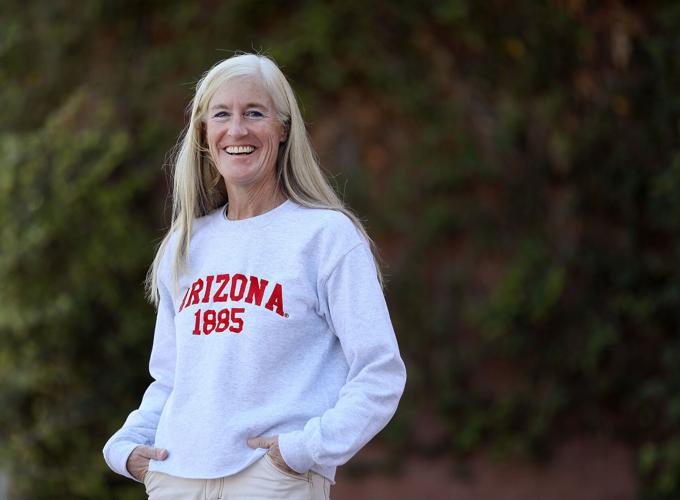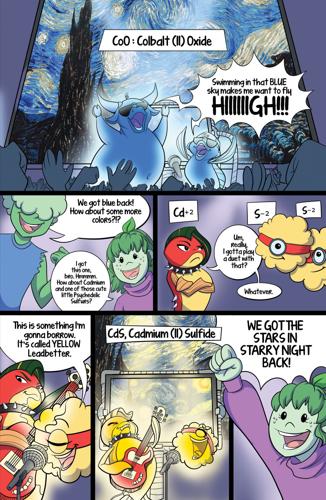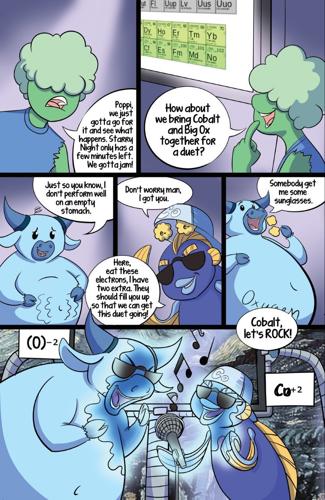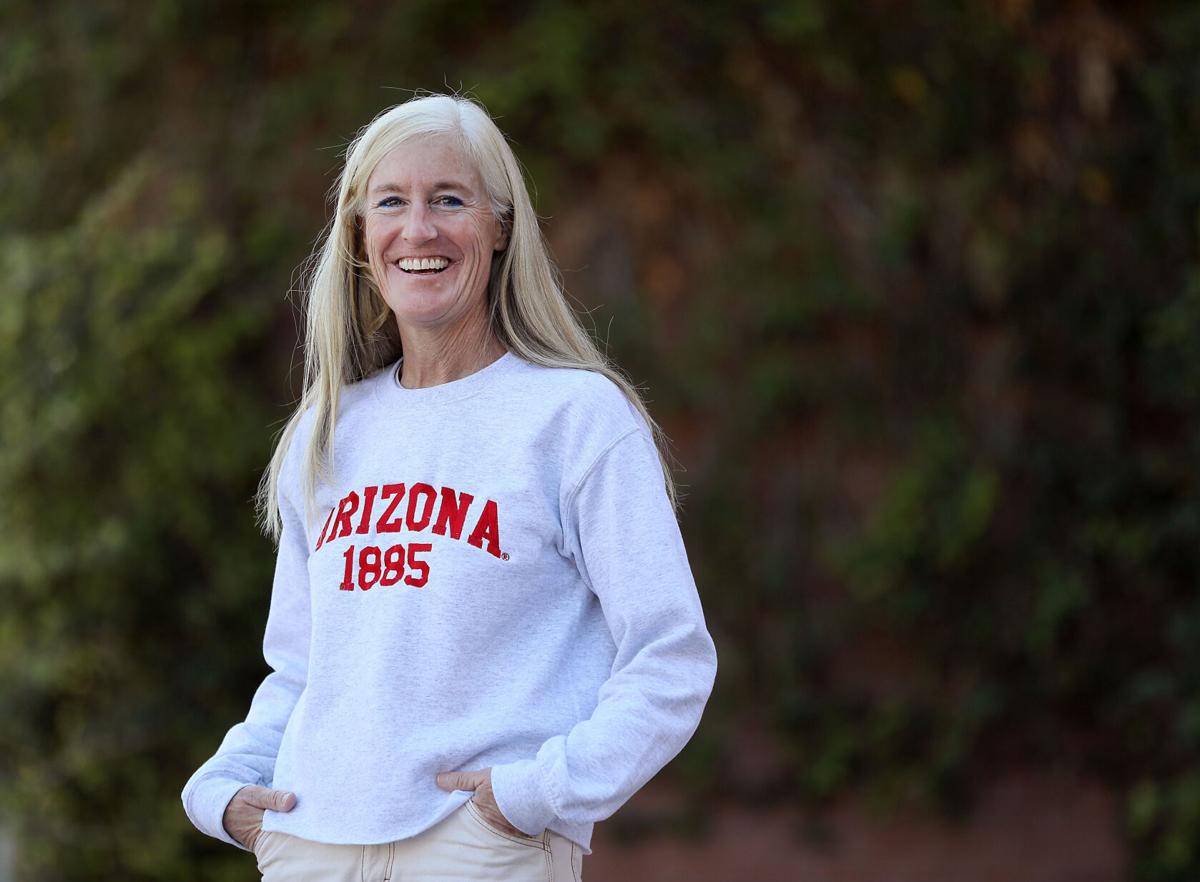After seeing inequities in science education throughout her 25-year teaching career, a UA chemistry instructor is taking a novel approach to solving the problem:
She’s writing comic books to help kids better understand the fundamentals of chemistry and to reframe the field as one anyone can get into.
About half of college students who start out majoring in science, technology, engineering or math fields — commonly known as STEM — don’t finish those degrees. And compared to their white, Asian and male peers, the attrition rates for Black, Latino, Native American and female STEM majors are disproportionately high.
“If you don’t get through organic chemistry, you’re thwarted from all the top-earning careers. It costs (underrepresented students) a couple million dollars in salary a year,” said the University of Arizona instructor, Colleen Kelley, who manages the organic chemistry teaching labs hundreds of STEM majors have to take each year.
“That’s a civil rights issue,” she said.
A 2020 study in the peer-reviewed journal Science Advances found that students from all backgrounds enter college intending to major in a STEM field at the same rate. But underrepresented minorities’ low performance relative to their capabilities in required general chemistry courses contributed to their especially high attrition rates in STEM majors.
And that underrepresentation in higher education carries over to the STEM workforce, which includes lots of jobs with high earning potential. Despite some gains for women in recent years, those jobs remain dominated by white and Asian men.
Powerful solutions to global challenges
Kelley previously taught chemistry at the high school and community college levels, but she started her career at Northern Arizona University. That’s where she was first confronted with students’ apprehension about learning organic chemistry.
At first, she expected every student would share her enthusiasm for a field she likens to solving a mystery capable of yielding powerful solutions to a wide spectrum of global challenges — like developing life-saving medication or producing clean drinking water.

A panel from the comic book, "The M.C. Detective Agency: Chemical Solutions Required," written by Colleen Kelley and illustrated by Mackenzie Reagan.
Instead, Kelley said, she’d walk in the classroom and “they’d look at me like I was the female Darth Vader. They were great students, but they were so frustrated.”
That’s because “all of the tools they had used before organic chemistry were based on math. Even if they didn’t understand any chemistry they could ‘math their way through it,’” Kelley said.
“Then they got to organic chemistry, which is all symbols and no numbers, and they have zero tools and they’re frustrated because they’ve never been taught to solve puzzles like this, let alone be graded on it.”
Teaching through storytelling
Out of desperation to help her students grasp the fundamentals of chemistry, Kelley turned to storytelling and referenced well-known characters from the Winnie-the-Pooh series to get the point across.
“I’d tell students that Fluorine is a lot like Piglet and clings on to molecules, holds on tightly, and doesn’t like to be left alone and is scared and tiny,” she said. “When I told these stories I knew they were developing the mental imagery and imagination required to see” how chemistry works.
The stories were so effective that she kept telling them when she started teaching at The Gregory School in Tucson, which is where she worked before coming to the UA in 2018. Students responded so well to the stories, that eventually she started writing them down.
The stories started out as simple sketches, but a few years ago she came up with the idea to create her own original 10-book comic series called M.C. Detective Agency: Chemical Solutions Required, which involves characters who embody different chemical elements.
Long-term, she’d like to develop her ideas into an animated series — think the 1990s TV show Magic School Bus — because she believes a show would have the best chance at reaching a broad public school audience, which relies on a tightly controlled curriculum.
For now though, Kelley is focused on bringing her comic books to life. While they could benefit learners from ages 8 to 108, they’re intended for elementary school students.
“Everyone is trying so hard to remedy (inequities in STEM education), but we can’t remedy it unless we go back to fourth grade,” she said, noting that kids need to get comfortable with chemistry early on so they’re not intimidated and confused when they get to high school and college.
Students from all communities, especially those underrepresented in STEM fields, also need to to feel included in these fields, she said. And that involves considering storytelling as “at least one approach worth trying.”
“Making a Lego figure be African-American may make people feel good, but it’s not going to solve this problem,” Kelley said. “This problem is really about understanding symbols and being about to translate that.”
Searching for publisher, funding
Kelley attended workshops on writing for children to refine her writing skills, and aside from some generous donations, has funded the project — it takes about $10,000 to produce one book — entirely on her own.
She recently launched her own startup, Kids’ Chemical Solutions, as part of the current cohort of the National Science Foundation Innovation Corps, which helps scientists figure out how to amplify the reach of their research.
Kelley is still in search of other forms of funding for the series and she’s also looking for a publisher. She said it was a challenge for major publishers to understand the intent behind her work until she developed the comics.
But now that she’s already finished one prototype book, “The Case of the Vanishing van Gogh,” she’s hopeful someone will pick it up.
The pilot comic tells the story of how detectives Poppi and Ray solve the mystery of why, when a band member from “The Heavy Metals” plays a duet with a band member from “The Polyatomics,” certain colors reappear in Vincent van Gogh’s famous painting, “Starry Night.”
“Fun and easy to understand”
To bring her vision to life, she enlisted the help of a graphic designer and the artistic eye of a former student, Mackenzie Reagan, to help conceptualize the characters into professional quality figures.
Reagan, who is now a junior at the Savannah College of Art and Design, was thrilled to work as a concept artist on the project, especially because she remembers how much she was able to get out of Kelley’s class in high school.
“Growing up, I always heard that chemistry is the hardest subject to get through in high school,” said Reagan, who is a self-described “creative, free-thinking” type. “For people like me, it is a daunting subject. Colleen’s stories made it so fun and easy to understand. It caught my attention and made me more excited about the class and chemistry in general. I can’t think of anybody who doesn’t like a good story.”

A panel from the comic book, "The M.C. Detective Agency: Chemical Solutions Required," written by Colleen Kelley and illustrated by Mackenzie Reagan.
Kelley has already started testing her books out with elementary school students across the country.
Recently, she brought a copy over to the home of Olivia Pearmain Grant, who is a third-grader at Tucson Hebrew Academy. “I like the stories. I like it because it was something I had to figure out,” said Olivia, who now has a shower curtain with a big, bright periodic table decorating her bedroom wall.
“Our education system is set up to dissuade women in this field,” said Olivia’s mother, Stephanie Pearmain.
She’s exposing her daughter to Kelley’s way of teaching chemistry through storytelling with the idea “that because of her young age, these concepts will come early in a digestible way.”
Doing so, she hopes, “will remove a lot of the stuff that comes later that prevents kids — particularly girls — from leaning in.”
Wanted: Diverse pool of STEM students
The widespread use of high-stakes standardized exams to measure students’ understanding of STEM subjects is one of the major factors keeping girls and other minorities from building the skills and confidence they need to succeed as STEM majors, said Vicente Talanquer, a professor of chemistry at the UA.
According to data from the Arizona Department of Education, in 2019 45% of white students and 51% of Asian students in the Tucson Unified School District passed the mathematics portion of the AzMERIT state test. On the same test, 19% of African-American students, 26% of Hispanic or Latino students and 14% of Native American students passed.
“There’s a lot of research that shows that students from certain groups do not perform well on those exams, not because they don’t have the knowledge but because those exams are not the proper tool to explore their understanding,” said Talanquer, who also chairs the American Chemical Society’s division of chemical education. In that role, he works with K-12 and college educators as well as industry leaders to enhance the teaching and learning of chemistry.
“It’s very difficult to engage in a subject in which you don’t see yourself represented, and when you don’t see people talking about the problems that affect you and your community or see yourself represented in the textbooks,” Talanquer said. “You are likely to develop the sense that you don’t belong here.”
From what Talanquer has seen, teaching STEM typically happens in a passive way, with teachers acting as the owners of the information.
But using a more active approach — like what Kelley is doing with her comic books, or relying on more project-based learning and contextualizing the material in its real-world applications — will attract a more diverse pool of students in K-12 and higher education, Talanquer said.
“The way we teach STEM in general tends to turn off a significant number of students, and in particular students who are underrepresented in STEM,” he said. “We lose students because we are unable to show how important and relevant STEM education is to address the grand challenges humanity is facing, from global warming to pollution. But I don’t think students see that, particularly in these introductory courses.”







